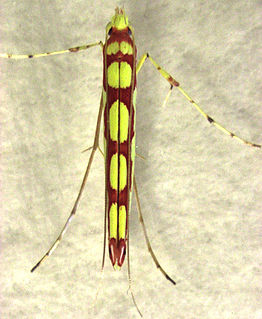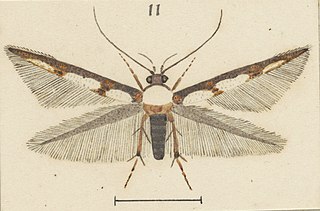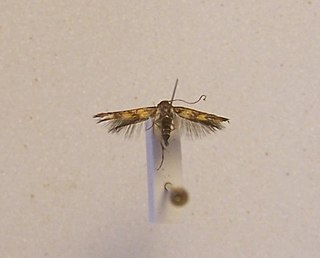
Eudonia philerga is a species of moth of the family Crambidae. This species was first described by Edward Meyrick. It is endemic to New Zealand and is found throughout the country. E. philerga is regarded as being common. Larvae feed on moss and the adults have been observed on the wing more frequently from October to April. Adult moths are attracted to light.

Asaphodes is a genus of moths in the family Geometridae erected by Edward Meyrick in 1885. This genus is endemic to New Zealand and species within this genus are found throughout New Zealand including the North, South and Stewart / Rakiura Islands.

Parienia is a genus of moths belonging to the subfamily Olethreutinae of the family Tortricidae. This genus was described by Edward Meyrick in 1881. It consists of only one species, Parienia mochlophorana, which is endemic to New Zealand.

Macarostola miniella is a species of moth in the family Gracillariidae. It is endemic to New Zealand. This species is only found in the North Island and the adult moths have two different colour variations.

Stathmopoda campylocha is a species of moth in the family Stathmopodidae. It is endemic to New Zealand. It is classified as critically endangered by the Department of Conservation.
Stathmopoda endotherma is a species of moth in the family Stathmopodidae. It is endemic to New Zealand. It is classified as "At Risk, Naturally Uncommon" by the Department of Conservation.

Stathmopoda holochra is a moth of the family Stathmopodidae. It was described by Edward Meyrick in 1889 using specimens first collected at the Wellington Botanic Garden. It is endemic to New Zealand. The larvae of this species feed on Phormium seed heads.

Stathmopoda skelloni, the yellow featherfoot, is a species of moth in the Stathmopodidae family. It is endemic to New Zealand and can be found throughout the country. This species inhabits native forest, coastal dunes and shrubland as well as cultivated gardens and orchards. The larvae of this species feed on a variety of plant species including agricultural crops such as kiwifruit and persimmons. The adult moths are on the wing from September until March and are nocturnal but are attracted to light.

Aristotelia paradesma is a moth of the family Gelechiidae. It was described by Edward Meyrick in 1885 and is endemic to New Zealand. This species has been observed on both the North and South Islands. The larvae feed on Coprosma species creating and living in stem galls. The adults are on the wing from November to March and are attracted to light.

Agriophara is a genus of moths in the subfamily Stenomatinae. The genus was erected by Rudolph Rosenstock in 1885.
Scythris niphozela is a species of moth in the family Scythrididae. It is endemic to New Zealand. It is classified as "At Risk, Naturally Uncommon" by the Department of Conservation.

Stathmopoda aristodoxa is a species of moth in the family Stathmopodidae. It is endemic to New Zealand. It is classified as "At Risk, Naturally Uncommon" by the Department of Conservation.

Tingena is a genus of the concealer moth family (Oecophoridae). This genus is endemic to New Zealand.

Mallobathra is a genus of moths belonging to the family Psychidae, and are bagworm moths. This genus was first described by Edward Meyrick. It is endemic to New Zealand. The type species of this genus is Mallobathra crataea.

Tingena anaema is a species of moth in the family Oecophoridae. It is endemic to New Zealand and has been collected at Lake Wakatipu, Invercargill and Stewart Island / Rakiura. The adults of the species are on the wing in December.

Tingena homodoxa is a species of moth in the family Oecophoridae. It is endemic to New Zealand and is found in the southern parts of the South Island. It inhabits open grassy slopes and is on the wing from November until January.

Tingena nycteris is a species of moth in the family Oecophoridae. It is endemic to New Zealand and has been observed in the North and South Islands. This species inhabits native forest and scrubland and adults are on the wing from October to January.

Stathmopoda distincta is a moth of the family Stathmopodidae. It was described by Alfred Philpott in 1923. It is endemic to New Zealand.

Stathmopoda distincta is a moth of the family Stathmopodidae. It was described by Edward Meyrick in 1926. It is endemic to New Zealand.
Stathmopoda cephalaea is a moth of the family Stathmopodidae. It was described by Edward Meyrick in 1897. It is found in Australia and has been recorded in New Zealand.

















